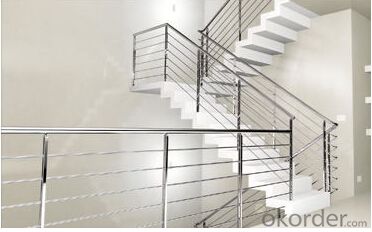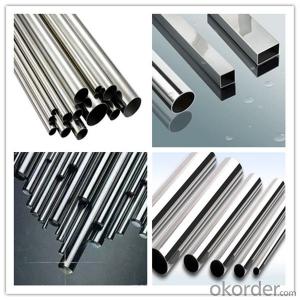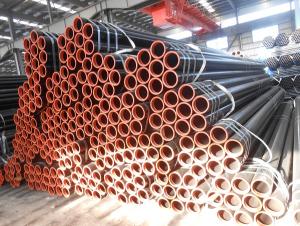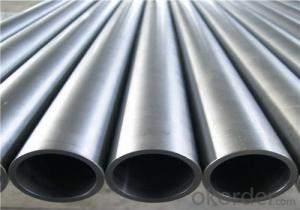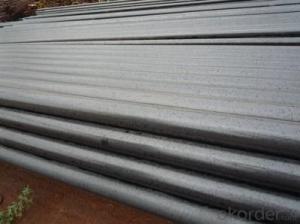Stainles Seamless Steel Pipe 201 /304 /316 /430 used for Oil Pipe Manufacturer
- Loading Port:
- China Main Port
- Payment Terms:
- TT or LC
- Min Order Qty:
- 30 m.t.
- Supply Capability:
- 12000 m.t./month
OKorder Service Pledge
OKorder Financial Service
You Might Also Like
1、Structure of Seamless Pipe ASTM A106/53:
carbon seamless steel pipes are widely used in gas, water and oil, transpotation;constructions;Bridge,highway,windows of model steel door; building materials;fences;heating facilities Fluid Pipe;conduit pipe,scaffolding pipe.etc.
Payment Terms: L/C D/A D/P T/T
Packing and shipment
Packaged in bundles,as per customers' requirements, it can also bepackagesd as beveled ends, typed marking, black painting, plastic caps protection,woven bags packing
For 20" container the max length is 5.8m; For 40" container the max length is 12m. other options are available based on customer requests. Please discuss when placing orders.
2、Main Features of the Seamless Pipe ASTM A106/53:
• High manufacturing accuracy
• High strength
• Small inertia resistance
• Strong heat dissipation ability
• Good visual effect
• Reasonable price
3、Seamless Pipe ASTM A106/53 Specification:
Standard | GB, DIN, ASTM ASTM A106-2006, ASTM A53-2007 |
Grade | 10#-45#, 16Mn 10#, 20#, 45#, 16Mn |
Thickness | 8 - 33 mm |
Section Shape | Round |
Outer Diameter | 133 - 219 mm |
Place of Origin | Shandong, China (Mainland) |
Secondary Or Not | Non-secondary |
Application | Hydraulic Pipe |
Technique | Cold Drawn |
Certification | API |
Surface Treatment | factory state or painted black |
Special Pipe | API Pipe |
Alloy Or Not | Non-alloy |
Length | 5-12M |
Outer Diameter | 21.3-610mm |
Grade | 20#, 45#, Q345, API J55, API K55, API L80, API N80, API P110, A53B |
Standard | ASME, ASTM |
1) Material:20#(ASTM A 106/A53 GRB.API5LGRB,GB),45#,16Mn,10#.
2) Specification range:OD:21.3-610mm,WT:6-70mm,length:6-12m or according to the requirement of clients.
3) Excutive standards:GB,ASME API5L.ASTM A 106/A53,Despite of the above standards,we can also supply seamless steel pipe with standard of DIN,JIS,and so on,and also develop new products according to the requirements of our clients!
4) Surface:black lacquered,varnish coating or galvanized.
5) Ends:Beveled or square cut,plastic capped,painted.
6) Packing:bundles wrapped with strong steel strip,seaworthy packing.
4、Packaging & Delivery
Packaging Details: | seaworthy package,bundles wrapped with strong steel strip |
Delivery Detail: | 15-30days after received 30%TT |
5、FAQ of Seamless Pipe ASTM A106/53:
①How is the quality of your products?
Our products are manufactured strictly according to national and internaional standard, and we take a test
on every pipe before delivered out. If you want see our quality certifications and all kinds of testing report, please just ask us for it.
Guaranteed: If products’ quality don’t accord to discription as we give or the promise before you place order, we promise 100% refund.
②How about price?
Yes, we are factory and be able to give you lowest price below market one, and we have a policy that “ for saving time and absolutely honest business attitude, we quote as lowest as possible for any customer, and discount can be given according to quantity”,if you like bargain and factory price is not low enough as you think, just don’t waste your time.Please trust the quotation we would give you, it is professional one.
③Why should you chose us?
Chose happens because of quality, then price, We can give you both.Additionally, we can also offer professional products inquiry, products knowledge train(for agents), smooth goods delivery, exellent customer solution proposals.Our service formula: good quality+good price+good service=customer’s trust
SGS test is available, customer inspection before shipping is welcome, third party inspection is no problem.
6、Seamless Pipe ASTM A106/53 Images:
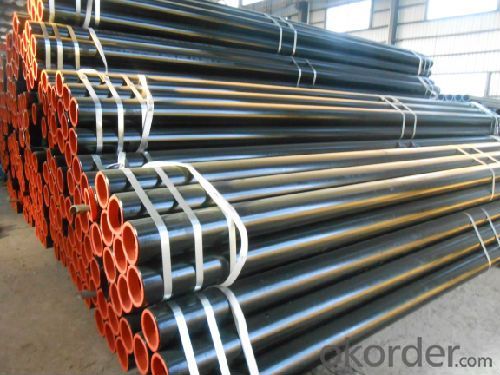
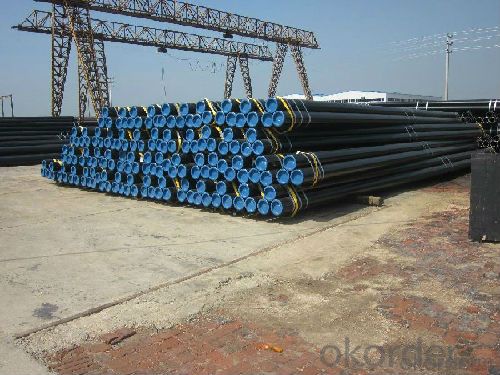
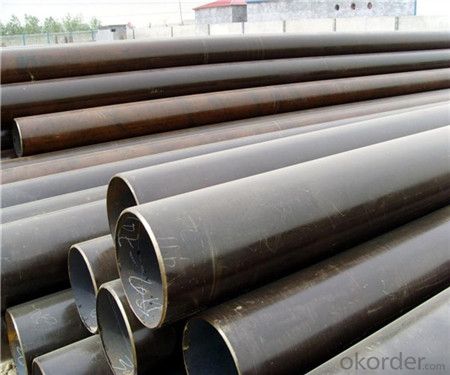
- Q: Are stainless steel pipes suitable for wastewater treatment plants?
- Yes, stainless steel pipes are suitable for wastewater treatment plants. Stainless steel is known for its excellent corrosion resistance, which is crucial in an environment where wastewater can contain aggressive chemicals and substances. Stainless steel pipes can withstand the high temperatures and pressures often encountered in wastewater treatment plants, making them a durable and reliable choice. Additionally, stainless steel pipes are easy to clean and maintain, reducing the risk of contamination in the treatment process. Therefore, stainless steel pipes are a popular choice for wastewater treatment plants due to their durability, corrosion resistance, and ease of maintenance.
- Q: What are the factors to consider when selecting stainless steel pipes?
- When selecting stainless steel pipes, it is important to consider factors such as the grade of stainless steel, corrosion resistance, temperature and pressure requirements, size and dimension of the pipes, and their intended application. Additionally, factors like cost, availability, and the reputation of the supplier should also be taken into account.
- Q: Are stainless steel pipes suitable for pharmaceutical factories?
- Yes, stainless steel pipes are suitable for pharmaceutical factories. Stainless steel is a popular material choice in the pharmaceutical industry due to its excellent corrosion resistance and hygienic properties. It is resistant to various chemicals and can withstand high temperatures and pressures, making it ideal for transporting and storing pharmaceutical products, chemicals, and other fluids. Stainless steel pipes also have a smooth surface, which promotes easy cleaning and prevents the accumulation of bacteria, ensuring the pharmaceutical products remain uncontaminated. Furthermore, stainless steel is a durable material with a long lifespan, reducing the need for frequent replacements and maintenance. Overall, stainless steel pipes are a reliable and suitable choice for use in pharmaceutical factories.
- Q: Stainless steel why rust?
- Stainless steel surface adhesion of organic juice (such as vegetables, soup, sputum), oxygen in the water under the circumstances, a long time, organic acid, organic acid on the surface of metal corrosion.
- Q: Can stainless steel pipes be used for food storage tanks?
- Yes, stainless steel pipes can be used for food storage tanks. Stainless steel is a preferred material for food storage and processing equipment due to its excellent corrosion resistance, durability, and hygiene properties. It is non-reactive, does not leach any harmful substances into the food, and can withstand high temperatures and rigorous cleaning processes. Additionally, stainless steel pipes can be easily cleaned and sanitized, ensuring the maintenance of proper food safety standards. Therefore, stainless steel pipes are commonly used in the construction of food storage tanks to ensure the safety and quality of stored food products.
- Q: What is the hardness of stainless steel pipes?
- The specific grade and treatment of the steel can cause variations in the hardness of stainless steel pipes. Stainless steel pipes exhibit a range of hardness levels, which are typically assessed using either the Rockwell scale or the Brinell scale. The hardness of stainless steel pipes surpasses that of other steel types due to the presence of alloying elements like chromium and nickel, which enhance resistance to corrosion and wear. Ordinarily, stainless steel pipes fall within the hardness range of 75 to 180 on the Rockwell scale or 150 to 300 on the Brinell scale. Nonetheless, it's worth noting that factors such as heat treatment, welding, and cold working processes can also affect the hardness.
- Q: What is the difference between seamless and SAW stainless steel pipes?
- Seamless and SAW (Submerged Arc Welding) stainless steel pipes are both used in various industries for transporting fluids or gases, but there are some key differences between the two. 1. Manufacturing Process: The main difference lies in their manufacturing processes. Seamless stainless steel pipes are made by piercing a solid billet to form a hollow tube, while SAW pipes are made by welding multiple layers of steel plates together using a submerged arc welding technique. 2. Appearance: Seamless pipes have a smooth and polished surface, giving them a more aesthetically pleasing look. On the other hand, SAW pipes have visible welding seams, which can be either internal or external. 3. Strength and Durability: Seamless pipes are generally considered to be stronger and more durable than SAW pipes. The absence of welding seams in seamless pipes eliminates any potential weak points, making them less prone to failure under high pressure or extreme temperatures. 4. Size Range: Seamless pipes are available in a wider size range, ranging from small diameters to large ones. SAW pipes, due to the limitations of the welding process, are typically used for larger diameter pipes. 5. Cost: SAW pipes are generally more cost-effective than seamless pipes. The manufacturing process of SAW pipes involves welding multiple plates together, which is less expensive than the process of creating a seamless pipe from a solid billet. 6. Applications: Seamless pipes are commonly used in industries where high pressure and corrosion resistance are crucial, such as oil and gas, petrochemical, and power generation. SAW pipes, due to their larger size range and cost-effectiveness, are often used in infrastructure projects like water supply, sewage systems, and construction. In summary, the main differences between seamless and SAW stainless steel pipes lie in their manufacturing process, appearance, strength, size range, cost, and applications. The choice between the two depends on the specific requirements of the project and the desired characteristics of the pipe.
- Q: Can stainless steel pipes be welded to other materials?
- Yes, stainless steel pipes can be welded to other materials. However, it is important to consider the compatibility of the materials being welded together and ensure proper welding techniques are used to achieve a strong and reliable joint.
- Q: Are stainless steel pipes suitable for underground sewage systems?
- Yes, stainless steel pipes are suitable for underground sewage systems. Stainless steel pipes are known for their durability, strength, and resistance to corrosion, making them an excellent choice for underground applications. They have a long lifespan and can withstand the harsh conditions typically found in sewage systems, such as exposure to moisture, chemicals, and varying temperatures. Additionally, stainless steel pipes have a smooth interior surface, which helps prevent the buildup of debris or waste, reducing the risk of clogs or blockages. Overall, stainless steel pipes provide a reliable and long-lasting solution for underground sewage systems.
- Q: Are stainless steel pipes suitable for solar power plants?
- Stainless steel pipes are indeed suitable for solar power plants due to their exceptional corrosion resistance and durability. With its outstanding qualities, stainless steel emerges as an ideal material for diverse applications within solar power plants. These pipes can endure severe weather conditions, high temperatures, and exposure to sunlight and moisture without succumbing to corrosion or degradation. Moreover, stainless steel pipes possess high thermal conductivity, facilitating efficient heat transfer in solar thermal systems. They are also lightweight and easily installed, rendering them a convenient option for constructing solar power plants. All in all, stainless steel pipes guarantee long-lasting performance and reliability in solar power plants, making them an appropriate choice for this particular application.
Send your message to us
Stainles Seamless Steel Pipe 201 /304 /316 /430 used for Oil Pipe Manufacturer
- Loading Port:
- China Main Port
- Payment Terms:
- TT or LC
- Min Order Qty:
- 30 m.t.
- Supply Capability:
- 12000 m.t./month
OKorder Service Pledge
OKorder Financial Service
Similar products
Hot products
Hot Searches
Related keywords




